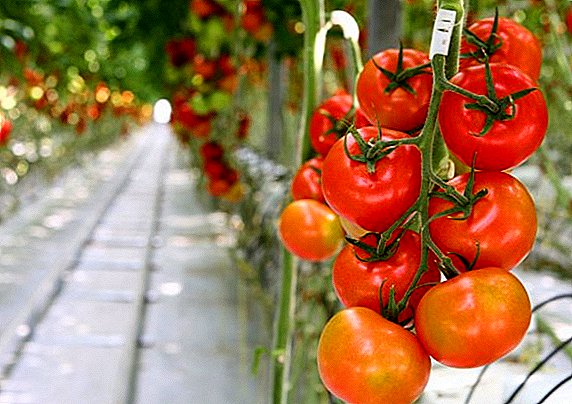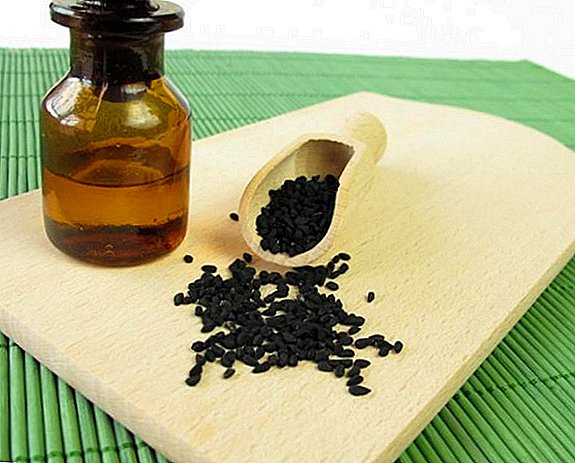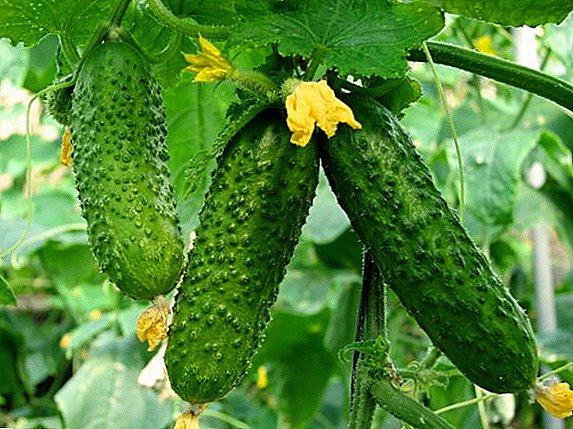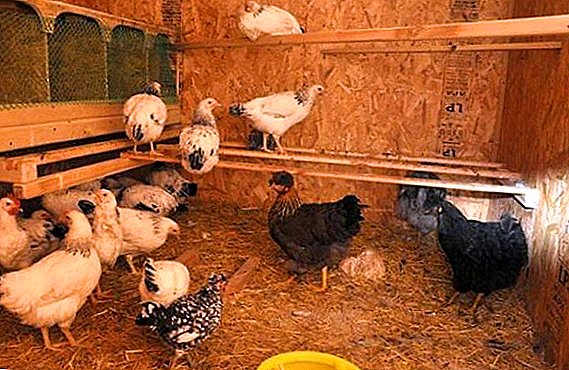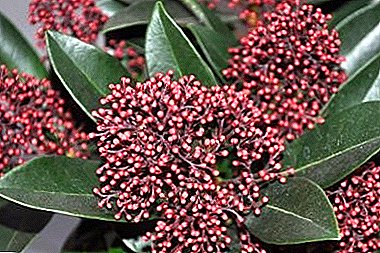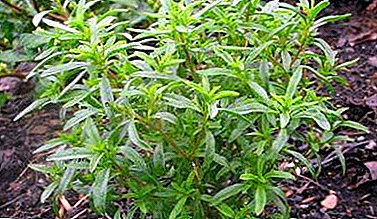
Savory is often confused with thyme due to its similarity in the names. But besides the fact that these two plants are herbs, they have nothing in common.
The article will tell about the proper cultivation of savory, namely how to choose a place and soil, as well as at what time it is necessary to start planting.
We will study the general rules of plant care, the features of planting at home, as well as find out what diseases can harm the plant.
Where is growing?
Under natural conditions, savory grows in the countries of the Mediterranean and Asia. It was from there that this spice came to the European continent.
The choice of location and soil
 Savory - light and heat-loving plants. Therefore, for planting seeds or seedlings is best to choose a place open to the sun. The place should be well ventilated, but at the same time protected from drafts. Savory can grow in any kind of soil. But it is still better to choose more fertile soils for planting. It digs the ground twice a year - in the fall and spring - to a depth of 25 centimeters, then it is leveled and tamped a little.
Savory - light and heat-loving plants. Therefore, for planting seeds or seedlings is best to choose a place open to the sun. The place should be well ventilated, but at the same time protected from drafts. Savory can grow in any kind of soil. But it is still better to choose more fertile soils for planting. It digs the ground twice a year - in the fall and spring - to a depth of 25 centimeters, then it is leveled and tamped a little.
In the autumn period after loosening the soil should be fertilized. Compost or humus is ideal for this. On one square meter of land you need to prepare about 5-6 pounds of feeding.
The most suitable precursors for savory are tomatoes and cucumbers, because during their cultivation the soil is saturated with organic matter.
To make the ground lighter, you can add a little river sand to it during digging. If the earth has high acidity, it is better to add lime to it.
After all these manipulations, the gardener will receive the most fertile soil for growing this spice.
Time for sowing
Almost all varieties of savory are cold-resistant, they can be planted as seeds immediately in open ground. It is only necessary to wait for the earth to warm up by 10-15 centimeters to at least 5-6 degrees of heat.
However and small night frosts spice will easily transfer. Usually the plant is sown in open ground in late April-early March. Of course, in the southern regions these periods begin a little earlier - the soil will warm up there already by the end of March.
But in the northern part of Russia, it is better to use the seedling method. To do this, the seeds are sown indoors at the end of March, and in early June they are transferred to open ground.
However, there are some varieties that react painfully to frosty nights, so they are better planted near the end of May. Information on frost resistance is usually indicated on the package.
Planting in open ground
Seeds
 Collecting your seed is not always possible. However, despite the fact that the plant is an annual, it often grows and the next year. This is due to the fact that the seeds fall out of the bolls (usually this process happens in mid-September) and are sown independently. To avoid this, you need to have time to cut the spicy twigs before the start of this process - in August.
Collecting your seed is not always possible. However, despite the fact that the plant is an annual, it often grows and the next year. This is due to the fact that the seeds fall out of the bolls (usually this process happens in mid-September) and are sown independently. To avoid this, you need to have time to cut the spicy twigs before the start of this process - in August.
So, the acquired seeds need to soak before planting.
- To do this, they can be wrapped in gauze fabric and immersed in a container with water for a day, or you can simply moisten gauze, fold it in several layers and spread the seeds on it. But only in this case the gauze will need to be constantly sprayed so that it does not dry out.
- Thus, the seeds must also lie down for 24 hours.
After soaking the seeds should be allowed to dry naturally.
At this time, preparing the site. It must be cleaned of weeds, otherwise the seeds will not pass. The soil should be fed as described above..
Next, the seed is placed in the ground.
- To do this, prepare the grooves with a depth of no more than 3 centimeters and carefully watered.
- It is necessary to fill in so that in the grooves turned swamp, but before landing it should dry out a bit.
- It is advisable to sprinkle seeds not with soil, but with humus.
The first shoots should appear within 10-15 days.
Seedlings
Consider how to grow seedlings. Seeds are usually sown in mid-March. For this, it is best to purchase a ready-made substrate intended for growing indoor plants. Capacity for planting can be any, but the most suitable option is peat or ordinary plastic cups. The main thing is that their volume was small. This is necessary in order not to injure the seedlings during transplantation in open ground, and move it immediately with a clod of soil. In this case, sow no more than 2 seeds in each cup.
After planting, the soil is moistened, each container is covered with a film or glass. At the same time every day the film needs to be cleaned for 15 minutes to harden the seedlings. A week before planting on a permanent place, saplings should be taken out onto the street for 10 minutes in order for the sprouts to get used to street conditions. Water the seedlings need as the soil dries.
 It is possible to transfer seedlings to a permanent place already from mid-May, and in the northern regions this period is shifted a month in advance.
It is possible to transfer seedlings to a permanent place already from mid-May, and in the northern regions this period is shifted a month in advance.
Transplant is performed as follows:
- grooves equal to cup sizes are being prepared on the site;
- wells plentifully watered;
- it will be good if the vegetable grower places a drainage layer of expanded clay or broken brick into each well;
- then the seedlings are removed from the cups, for this it is better to slightly beat along the walls of the container;
- the extracted seedlings together with a lump of earth are planted in the holes and sprinkled with a small layer of humus.
Important nuances
Pre-pour the wells with plenty of water., then fill up the seeds or seedlings with a small amount of humus and water from above once more plentifully. This is necessary in order to soil a little rammed.
General rules of care
Temperature
Savory is a plant resistant to low temperatures. It will not die at temperatures up to 5-6 degrees Celsius. However, it will not grow. The minimum temperature at which the spice will develop - 10 degrees of heat.
The most optimal air heating for the described plant is 18-23 degrees.
If the air becomes much warmer, there is a danger that the spice will simply dry out. Therefore, in this case it is important that the soil is sufficiently moist.
Lighting
Savory prefers light, open to the sun areas. In the shadows it will develop less.
Under natural conditions, this spice grows almost to a meter in height. But in the garden area savory usually reaches half a meter.
The plant is not afraid of direct sunlight., if at the same time the soil will be moderately wet.
Top dressing
For savory it is enough to feed one per month.
- For this, humus or compost is used. It is necessary to dilute 1 kg of fertilizer in a 10-liter bucket. This bucket lasts for 1.5 square meters.
- You can also use the ash solution. For its preparation matchbox wood ash bred in a bucket of water. Consumption is the same as for manure.
Loosening
After each watering you need to loosen the soil. Soil before this should shake a little. Loosening is necessary so that a dry crust does not form, which will interfere with air circulation.
Weeding
Weeds are the enemies of savory. They prevent him from fully growing and developing by slaughtering the plant. Therefore, it is important to regularly get rid of unnecessary weeds. This procedure can be combined with the process of loosening.
Especially seeding at home
 You can sow seeds at home at any time of the year. For this fit the finished substrate, which is sold in a flower shop. Drainage layer - a prerequisite. You can prepare the substrate yourself. To do this, take:
You can sow seeds at home at any time of the year. For this fit the finished substrate, which is sold in a flower shop. Drainage layer - a prerequisite. You can prepare the substrate yourself. To do this, take:
- 4 pieces of leaf or sod land;
- 2 hours peat;
- and 1 h. river sand.
Seeds do not sink more than 1 centimeter to the ground. You can choose absolutely any capacity for planting, even a flower pot will do.
But you need to put savory on a well-lit place, preferably away from heating appliances.
It is not necessary to flood the plant so that the roots do not rot.
How fast is growing?
Absolutely no matter how the gardener planted spice. The ripening date starts from the date of first shoots. Cut the branches of the plant can be in the case when they have reached a height of at least 30 cm. It usually takes about a month.
It is necessary to cut off so that the stumps remain about 5 centimeters, which will provide the vegetable grower with the next batch of spices. It is advisable not to allow savory to bloom, otherwise the taste will change. Therefore, you need to regularly update the plant, cutting it. If you do not have time to use it, dry in advance.
Diseases and pests
Due to the fact that savory has a pronounced spicy aroma, pests rarely attack this plant. However, in rare cases such insects can attack savory:
- meadow moth;
- aphid;
- weevil.
To combat them, it is enough to spray the plant with insecticides or soap solution (it is better to use soap - 50 grams per liter of water).
From diseases, savory can catch fungal infections. They often develop due to excessive watering. Therefore, noticing any rotting on the stems, let the soil dry out a bit and adjust its moisture mode.
Savory is a very common spice. If your site has free space, you can try to plant this plant. It does not require special growing conditions, but at the same time it will give you fresh sprigs of spices regularly. These stems can be used both in fresh and dried, which allows you to have spices from your site all year round.


